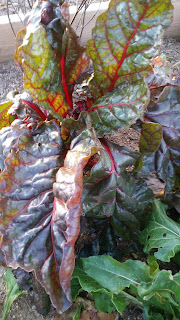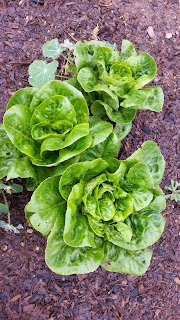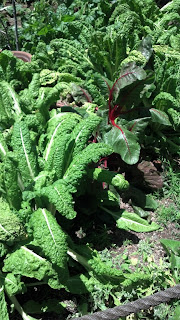 |
| Vulcan Swiss Chard growing in raised beds with Beets |
Plant seeds 1/4 inch deep in moist soil. It is best to sow lettuce or spinach seeds thinly in rows spaced about 1 ft. apart or simply scatter the seeds in blocks. Cover lightly with soil, firm in place and water well. Keep the soil moist until germination. Once the plants have a grown their true leaves, you can begin to thin the plants to about 6" apart.
 |
| LITTLE GEM LETTUCE |
Start lettuce or spinach indoors or direct seeded in the garden as soon as the soil is workable. Great for container gardens.
Depending on the type of lettuce, harvest outer leaves only or cut down the whole head.
Spinach can be harvested in the cut and come again method of harvesting lettuce. Cut individual leaves, starting with the older, outer leaves, and letting the young inner leaves remain and continue growing for a later harvest. You can also cut down the whole plant, for a larger harvest.
Tip: Soak seeds overnight in water before planting to ensure strong germination.
 |
| HUGE SWISS CHARD |
Plant seeds 1/4 inch deep and 3 inches apart. Set out seedlings 8 inches apart. Indoors or out, thin newly germinated seedlings with cuticle scissors instead of pulling them out. Chard seed capsules often contain two or more seeds. If more than one germinates snip off all but the strongest sprout at the soil line. Gradually thin direct-sown seedlings to 8-12 inches apart.
Harvest individual leaves from the outer area but be sure to leave the crown intact.
Frequent picking helps to stimulate the production of new leaves. Rinse leaves with cool water immediately, shake off the excess moisture, and store in plastic bags in the refrigerator for up to four days.
 |
| ENDIVE |
Companion Plants for GREENS
Chards: Bean, cabbage family, tomato, onion and roses. Don't overlook chard's value as an ornamental plant in flower beds or wherever you have room for it. Don't grow chard near cucurbits, melons, corn or herbs.
Lettuce: Does well with beets, broccoli, bush beans, pole beans, carrots, cucumbers, onion, radish and strawberries. It grows happily in the shade under young sunflowers. Dill and lettuce are a perfect pair. Keep lettuce away from cabbage. Cabbage is a deterrent to the growth and flavor of lettuce.
Spinach: Plant with peas and beans as they provide natural shade for the spinach. Gets along with cabbage, cauliflower, celery, eggplant, onion, peas, strawberries and fava bean. Plant spinach with squash. It's a good use of space because by the time squash plants start to get big the spinach is ready to bolt.
TIPS for growing GREENS
-Make sure soil remains moist but is well drained.
-
You should be able to sow additional seeds every two weeks for a continuous harvest throughout the growing season
-
Consider planting rows of chives or garlic between your lettuce to control aphids. They act as “barrier plants” for the lettuce
-Lettuce will tell you when it needs water. Just look at it. If the leaves are wilting, sprinkle them anytime—even in the heat of the day—to cool them off and slow down the transpiration rate.
-Weed by hand if necessary, but be careful of plant roots: They are shallow.
Recipe for your GREENS Harvest
Herb Salad with Creamy Lemon Dressing
Homemade Flatbread topped with Eggplant and Kale
Quick and easy Pear, Cranberry and Spinach Salad
Radish and Cucumber Salad
Sign up for our E-Newsletter



2 comments
Mary you are a great teacher and person. I appreciate everything you teach us about gardening.
Thank you for educating us in the Art of Gardening!
It truly is an art & you are a master!
You give us just enough instruction to encourage but not overwhelm.